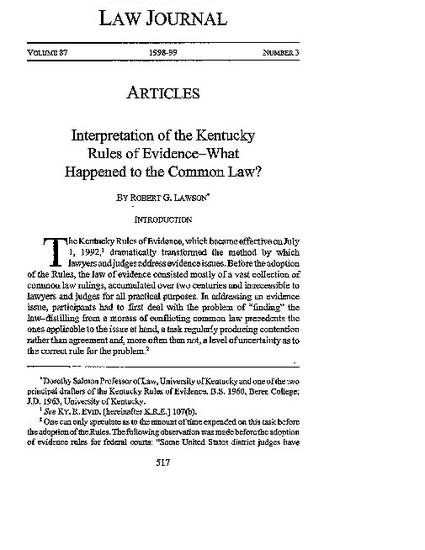
The Kentucky Rules of Evidence, which became effective on July 1, 1992, dramatically transformed the method by which lawyers and judges address evidence issues. Before the adoption of the Rules, the law of evidence consisted mostly of a vast collection of common law rulings, accumulated over two centuries and inaccessible to lawyers and judges for all practical purposes. In addressing an evidence issue, participants had to first deal with the problem of "finding" the law-distilling from a morass of conflicting common law precedents the ones applicable to the issue at hand, a task regularly producing contention rather than agreement and, more often than not, a level of uncertainty as to the correct rule for the problem.
The Evidence Rules, on the other hand, substitute for this enormous collection of cases a set of carefully defined provisions that are readily accessible to all participants and that provide a clear starting point for the analysis of most evidence issues. In so doing, the Rules have transformed the task of resolving evidence problems from one of "finding" the law to one of "interpreting" the law-determining the meaning of a Rule and extending that meaning to the concrete facts and circumstances of the case. In making the law more accessible, however, the Rules have exacted the cost of adding great significance to a host of questions concerning the proper approach to their interpretation.
The purpose of this Article is to focus some attention on the broad subject of how best to approach the interpretation of Kentucky's Rules of Evidence. Part I sets the stage for this discussion by providing a description of two recent Supreme Court of Kentucky decisions that raise truly far-reaching issues concerning interpretation of the Rules. Part II digresses from the main subject in order to provide necessary background about the legislative history of the Rules, the unusual method by which they were adopted, the reasons for use of that method, and the extent to which objectives were achieved. Part III reviews United States Supreme Court decisions interpreting the Federal Rules of Evidence, a recognized and accepted source of guidance for interpretation of the Kentucky Rules. Part IV reviews varying approaches to interpretation of evidence rules suggested by legal scholars. Parts V and VI discuss the interpretive approach that seems to be developing in Kentucky and identifies the crucial issues yet to be confronted and resolved. Part VII concludes the Article with an examination of evidence issues that are most likely to generate future interpretation issues for the Supreme Court of Kentucky.

Kentucky Law Journal, Vol. 87, No. 3 (1998-1999), pp. 517-582